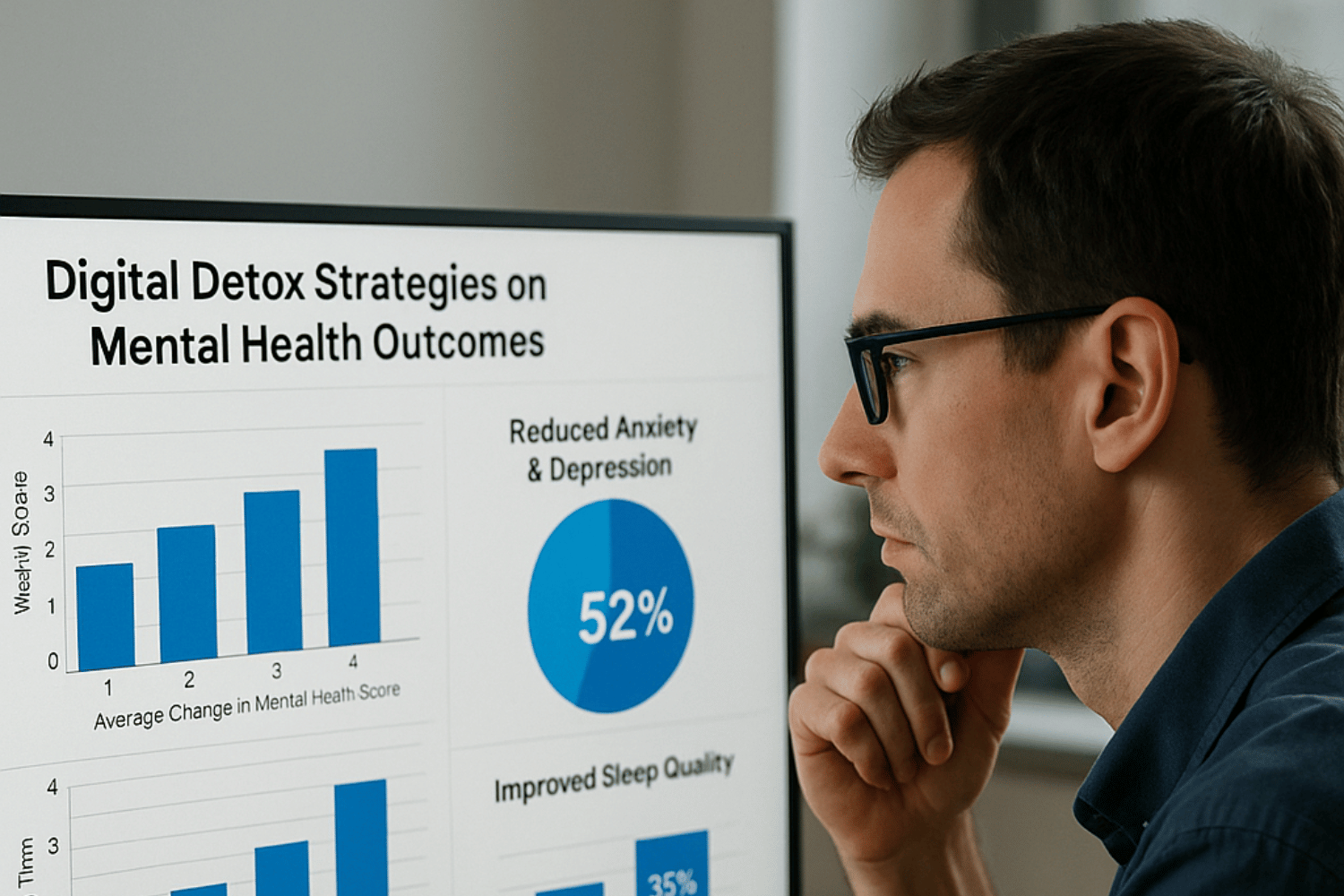Digital Detox Mental Health: Evidence-Based Benefits and Practical Implementation Guide
Key Takeaways
Understanding Digital Detox and Its Mental Health Impact
In our increasingly connected digital age, the constant barrage of notifications, social media feeds, and digital distractions has created an unprecedented challenge for our mental well being. A digital detox represents an intentional and temporary disconnection from digital devices and social media platforms to restore balance and improve psychological health.
The concept doesn’t require complete rejection of technology, but rather encourages developing a healthier relationship with digital tools. This approach recognizes that constant connectivity creates information overload and chronic stress responses that can significantly impact our mental health.
Research reveals that the average person now spends over 4 hours daily on digital screens, with many young people spending time well beyond this threshold. This extended periods of digital engagement contributes to what mental health professionals increasingly recognize as digital overwhelm – a state where our cognitive resources become depleted from processing the constant exposure to digital stimuli.
The psychological mechanisms linking excessive screen time to anxiety and depression are complex but well-documented. Constant connectivity disrupts our natural stress response systems, leading to elevated cortisol levels and chronic activation of fight-or-flight responses. Social media usage, in particular, triggers social comparison processes that can negatively impact self-esteem and overall well being.
When we examine our digital habits, we often discover that much of our phone time involves passive consumption rather than meaningful activities. This behavior pattern creates a cycle where we seek digital engagement to fill emotional voids, yet the very act of excessive digital engagement depletes our capacity for genuine connection and present moment awareness.
Proven Mental Health Benefits of Digital Detox
Digital detox offers several benefits that directly address the mental health challenges created by excessive digital engagement. Perhaps most significantly, reducing social media use decreases social comparison tendencies that fuel feelings of inadequacy and FOMO (fear of missing out). When we step away from the curated highlight reels of others’ lives, we naturally develop a better sense of our own worth and accomplishments.
Enhanced sleep quality represents another crucial benefit. Eliminating digital screens for at least 60 minutes before bedtime allows natural melatonin production to resume, helping us fall asleep more easily and achieve deeper, more restorative sleep. Better sleep directly supports emotional regulation, cognitive function, and stress resilience.
Cognitive function improvements become apparent within days of reducing digital distractions. Without the constant fragmentation of attention from notifications and multitasking between various aspects of digital life, our ability to maintain increased focus on single tasks returns. Many people report feeling more fully present in conversations and activities, experiencing life with greater clarity and engagement.
The strengthening of real world connections provides profound mental health benefits. When we’re not constantly checking our phones or distracted by digital devices, we can invest more quality time in face-to-face relationships with loved ones. These authentic interactions trigger oxytocin release and provide the social support that serves as a protective factor against anxiety and depression.
Reduced anxiety and stress naturally follow from decreased information overload. The constant stream of news, social updates, and digital demands creates a state of chronic cognitive arousal. Taking breaks from this constant barrage allows our nervous systems to reset and return to baseline calm states.
Physical Health Improvements Supporting Mental Wellbeing
The physical health benefits of digital detox create a positive feedback loop that supports mental health recovery. Reduced eye strain and headaches from decreased screen time improve overall comfort and mood. Many people don’t realize how much chronic low-level discomfort from digital eye strain affects their emotional state until they experience relief.
Better posture results from spending less time hunched over digital screens, reducing neck and back pain that can contribute to irritability and stress. When our bodies feel better, our minds naturally follow suit.
Increased physical activity often fills the time previously spent on screen time. Whether through outdoor exercise, creative hobbies, or simply moving more throughout the day, this increased activity boosts endorphin production and supports cardiovascular health – both crucial for optimal mental wellbeing.
How to Start Your Digital Detox for Mental Health
Beginning a digital detox requires honest assessment of current digital habits and realistic goal-setting. Start by tracking your actual screen time using built-in phone settings or dedicated apps. Most people underestimate their digital engagement by 2-3 hours daily, so objective data provides essential baseline information.
Set specific, measurable goals that feel achievable rather than overwhelming. A first step might involve committing to device free periods during meals or the first hour after waking. These small changes can provide immediate benefits while building confidence for longer detox periods.
Creating tech free zones in your living space helps establish clear boundaries between digital and analog environments. The bedroom deserves special attention – removing electronic devices from sleep spaces can improve sleep quality within the first few nights of implementation.
Schedule specific times for checking notifications rather than maintaining constant connectivity. This approach, sometimes called “batching,” allows you to stay informed and connected while preventing the chronic attention fragmentation that depletes mental energy throughout the day.
Planning alternative activities prevents the boredom and restlessness that can derail detox efforts. Identify meaningful activities that genuinely interest you – reading, outdoor time, creative projects, meditation, or spending time with family. Having ready alternatives makes it easier to resist the urge to reach for digital devices during quiet moments.
Digital Detox Duration and Intensity Options
Weekend mini-detoxes work well for beginners who need to maintain work connectivity during weekdays. This approach allows you to experience the benefits of digital breaks while accommodating professional obligations. Many people find that even 48-hour breaks provide noticeable improvements in mood and focus.
Week-long complete social media breaks suit moderate users ready for more significant changes. This duration allows sufficient time to break habitual checking patterns while providing meaningful mental health benefits. Research suggests that one week represents a minimum threshold for experiencing substantial mood improvements.
Thirty-day comprehensive digital minimalism challenges appeal to heavy users committed to fundamental behavior change. This extended approach allows time to develop new routines, discover alternative means of entertainment and connection, and experience the full range of mental health benefits that digital detox can provide.
Gradual reduction approaches work best for those with work-related technology dependence. Rather than complete elimination, these strategies involve systematically reducing non-essential digital engagement while maintaining necessary connectivity. This might include deleting certain social media apps while keeping others, or limiting recreational screen time to certain hour periods.
Overcoming Digital Detox Challenges for Mental Health SuccessFOMO anxiety represents the most common initial challenge in digital detox efforts. Combat this by preparing alternative information sources for truly important updates, and reminding yourself that most “urgent” digital communications aren’t actually time-sensitive. Practice distinguishing between genuine needs for information and habitual checking behaviors.
Withdrawal symptoms including restlessness, boredom, and social disconnection feelings are normal and typically subside within 3-5 days. These uncomfortable sensations signal that your nervous system is adjusting from chronic stimulation to more natural rhythms. Viewing these symptoms as positive signs of healing rather than reasons to abandon your efforts helps maintain motivation.
Work-related connectivity requirements need thoughtful navigation. Communicate your digital wellness goals with colleagues and establish clear boundaries about response times. Many jobs that seem to require constant availability actually function well with structured communication windows. Consider using alternative means of urgent communication when needed.
Social pressure from family members or friends who don’t understand your detox goals can challenge your commitment. Explain the mental health benefits you’re seeking and invite others to join modified versions of your digital breaks. Often, resistance from others reflects their own concerns about their digital habits.
Creating accountability systems with trusted friends or family members provides motivation and support during challenging moments. Share your goals and check in regularly about your progress. Having someone to call during moments of strong digital cravings can make the difference between success and relapse.
Emergency Protocols and Flexibility
Establish emergency contact methods for urgent situations during complete detox periods. This might involve designating one person who can reach you through alternative means, or maintaining access to one device for true emergencies only. Clear protocols reduce anxiety about being unreachable while protecting your detox goals.
Build in structured check-in times for essential work or family communication. Rather than constant availability, schedule specific periods for necessary digital engagement. This approach maintains important connections while preserving the mental health benefits of extended offline time.
Adjust detox intensity based on your mental health responses and life circumstances. If initial approaches feel overwhelming or trigger increased anxiety, modify your plan rather than abandoning it entirely. Success comes through sustainable changes, not perfect adherence to rigid rules.
Recognize when to seek professional support if detox efforts trigger significant anxiety or depression. While digital detox provides substantial mental health benefits for many people, some individuals may need additional support from mental health professionals to address underlying conditions that digital engagement was masking.
Long-term Digital Wellness Strategies for Sustained Mental HealthImplementing regular weekly or monthly mini-detox periods creates sustainable mental health maintenance routines. Many people find that designating one day per week as a “digital sabbath” provides ongoing benefits while remaining achievable within busy lifestyles. These regular breaks prevent the accumulation of digital overwhelm that can lead to more serious mental health challenges.
Developing mindful technology use habits transforms your relationship with digital tools from reactive to intentional. This includes making conscious choices about which apps deserve space on your devices, setting clear boundaries around notification timing, and regularly evaluating whether your digital engagement supports or undermines your overall well being.
Creating digital boundaries through notification management and app time limits helps maintain the benefits of detox periods during regular technology use. Most smartphones now include built-in tools for monitoring and limiting usage. Use these features to create phone free zone during meals, before bedtime, and during other important activities.
Building offline hobbies and relationships reduces dependency on digital entertainment while providing genuine fulfillment. Whether through creative pursuits, physical activities, volunteer work, or deepening existing relationships, developing rich offline lives makes digital detox feel less like deprivation and more like choosing better alternatives.
Monitor mental health indicators and adjust digital habits based on mood and stress levels. Pay attention to how different types of digital engagement affect your emotional state. Some social media sites may consistently trigger negative emotions, while others might provide genuine connection and support. Regular self-assessment helps you maintain a healthy balance that supports rather than undermines your mental wellness.
Building Healthy Technology Relationships
Use technology tools to support rather than replace real world connections. Video calls with distant loved ones, apps that facilitate in-person meetups, and digital tools that enhance rather than substitute for face-to-face interactions can be part of a healthy digital diet. The key lies in ensuring that technology serves connection rather than becoming a substitute for it.
Choose quality digital content that enhances rather than depletes mental energy. Curate your social media feeds to include accounts that inspire, educate, or genuinely entertain without triggering comparison or negative emotions. Unfollow accounts that consistently leave you feeling worse about yourself or your life.
Practice digital gratitude by consciously appreciating beneficial technology uses. Acknowledge when digital tools genuinely improve your life – connecting with family, accessing helpful information, or facilitating meaningful work. This balanced perspective helps maintain a healthier relationship with technology rather than viewing all digital engagement as problematic.
Regularly evaluate and curate social media feeds to reduce negative mental health triggers. Social media platforms use algorithms designed to capture attention, often through emotionally provocative content. Take control by actively choosing what you see, using features to hide or limit certain types of content, and remembering that you have the power to shape your digital environment.
Your Questions Answered
How quickly can I expect to see mental health improvements from digital detox?
Research shows that significant improvements in mood and focus can begin within 24-48 hours, with more substantial changes in depression and anxiety symptoms appearing after 1-2 weeks of consistent digital breaks. Individual responses vary based on baseline digital usage and existing mental health status.
Can digital detox replace professional mental health treatment for depression or anxiety?
Digital detox is a supportive tool that can enhance professional treatment but should not replace therapy or medication for clinical depression or anxiety disorders. Mental health disorders require comprehensive care from qualified mental health professionals. Digital detox works best as part of a holistic approach to mental wellness.
What should I do if digital detox initially increases my anxiety or stress?
Some initial discomfort is normal, but persistent increased anxiety may indicate the need to adjust your approach. Start with shorter detox periods, maintain essential connections, and consider gradual reduction rather than complete elimination. If anxiety persists or worsens, consult with a mental health professional.
How do I maintain work productivity during a digital detox focused on mental health?
Create structured work-only technology use periods, use analog tools for planning and note-taking, batch communication into specific time blocks, and communicate boundaries clearly with colleagues to maintain professional effectiveness. Many people discover that focused, intentional technology use actually improves rather than hinders productivity.
Is it better to do complete digital elimination or gradual reduction for mental health benefits?
Both approaches can be effective depending on individual circumstances. Complete elimination provides faster reset benefits but may be difficult to sustain, while gradual reduction allows for easier habit formation and long-term compliance with less initial stress. Choose the approach that feels most sustainable for your lifestyle and mental health needs.











